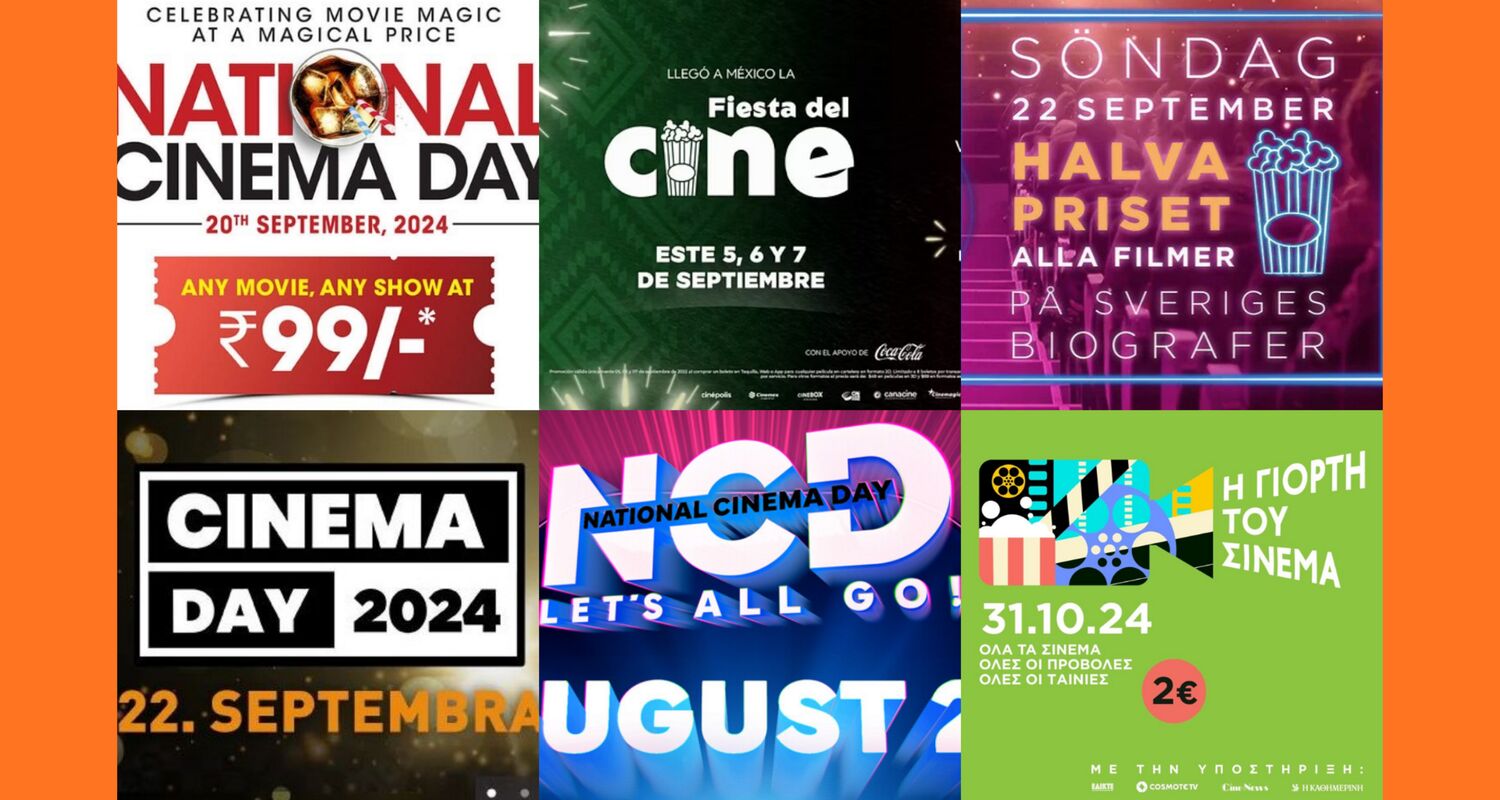National Cinema Days: Reclaiming the big screen
National cinema days have gained momentum across Europe and beyond in recent years. From one-day celebrations to coordinated, multi-day events, these initiatives are taking centre stage.
While countries like France and Spain have long-standing traditions, many others adopted similar schemes only after the COVID crisis, seeing them as a way to reconnect with audiences and revive the cinema-going habit.
The UK and Ireland launched their National Cinema Day in 2021, followed by Finland and Italy in 2022. In 2024, at least 15 European countries hosted such national events.
They offer a rare opportunity for the cinema industry to present a united front, with multiplexes, independents, and arthouses joining forces with distributors to celebrate cinema as a unique, communal experience.
With audiences steadily returning and renewed interest in local and European films, these events feel more relevant than ever. Yet behind the scenes, making them happen is anything but simple.

A complex recipe for success
A quick look across Europe reveals a remarkable diversity in format, branding, and scale, showing how differently each country approaches the initiative.
In France, the event takes place twice a year over three or four days, with €5 tickets and distinct promotional campaigns for each edition. Spain and Italy also run biannual events with €3.5 tickets, spanning four or five days, but unlike France, they use consistent naming and branding. Belgium opts for a single four-day campaign in September, while Germany and Poland concentrate theirs over a weekend. Sweden, Denmark and Finland all went for a one-day event offering tickets at half price.
These differences reflect more than just scheduling or pricing strategies. In some countries, cinema days are primarily focused on boosting attendance through discounts. In others, they serve as broader cultural celebrations, featuring special screenings, events and creative partnerships.
While all claim a national scope, they don’t always engage the full cinema landscape. And this is where the true complexity lies: getting all stakeholders to agree on the best format, given the many variables at play.
Coordination and compromises
Pricing is one of the biggest hurdles. Set the ticket price too low, and some distributors or exhibitors may hesitate to participate. Too high, and the incentive will vanish. Finding a sweet spot that works for multiplexes, independents, major studios, and arthouse distributors is essential.
Concerns about devaluing the cinema experience are common, but data suggests otherwise. Comscore and other box office experts regularly report about how these events attract frequent and infrequent cinema-goers who will return again, paying at full price.
Timing adds another layer of complexity. Cinema days generally avoid clashing with major releases or school holidays, but they also need to deliver strong attendance. That’s why many events are held on weekends or just ahead of a holiday season. Some will argue that cinema days should intentionally target high-potential periods to maximise their impact.
Programming is equally crucial. National and independent distributors must be willing to make content available, and a varied lineup is key to attracting all audiences.
Both major and independent distributors may have concerns. A blockbuster’s momentum could be diluted, while a smaller film could either be lost in the noise or benefit from the additional visibility. As always in this industry, it’s all about taking risks.
What truly makes or breaks these campaigns is collaboration. Without national coordination, unified messaging, and strong marketing support, a cinema day will go unnoticed. A lack of promotion also puts smaller cinemas at a disadvantage, leaving chains to dominate the conversation.
Sponsorship can help. Some countries rely on public or private partners to support large-scale promotional campaigns. But identifying the right sponsors is a challenge.
Data sharing also plays a vital role. Measuring impact and gathering feedback can help improve future editions and make a stronger case for continued support.
A successful and thriving format
Despite these challenges, more than a dozen national cinema days now exist across Europe.
In Italy, Cinema in Festa debuted in 2022 and already has confirmed dates through 2026. The event takes place twice a year, in June and September, over five days from Sunday to Thursday, with €3.50 tickets for all films. What’s particularly interesting is how it connects to Cinema Revolution, a government-backed initiative running from mid-June to mid-September, a typically low season for Italian cinemas. During this period, all Italian and European films are offered at €3.50, with the state subsidising €3 per ticket. In 2024, the campaign led to a 69% increase in admissions for European and Italian titles.
France’s Fête du Cinéma and Printemps du Cinéma remain central cultural fixtures. Despite an historic dip in 2024, the 2025 edition of Printemps drew 2.2 million visitors, a 29% increase from the previous year. Meanwhile, La Fête du Cinéma in early summer 2024 broke admission records, boosted by the success of two major French blockbusters: Le Comte de Monte-Cristo and Un p’tit truc en plus. These were the year’s top-performing national films, underscoring the significant impact such events can have on overall box office performance. In total, 4.65 million tickets were sold, the best-ever result for La Fête and a 50% increase from the previous year.
Spain’s most recent Fiesta del Cine in June 2025 also delivered its best results in five years, with 1.3 million admissions, a 52% increase on the 2024 edition. Once again, strong content played a central role, with titles like Lilo & Stitch and the latest Mission: Impossible drawing crowds. But it wasn’t just US blockbusters: local films such as Una quinta portuguesa and El casoplón also made it into the top 10 titles during the event.
In Germany, the third edition of Kinofest drew 1.2 million visitors in September 2024, making it the most successful weekend of the year. Switzerland, Poland, Finland, the UK and Ireland have all reported similar surges in attendance thanks to their own national cinema initiatives.
These events respond to multiple urgent needs: industry recovery, audience engagement, and cultural relevance. They are particularly well-positioned to attract youth and families, reconnect with lapsed cinema-goers, and lower the entry barrier for price-sensitive audiences.
Still, not all cinema days engage the full market. In some countries, there are no independent structures in place to organise at scale. Even in Germany, Kinofest involved 700 cinemas, representing around 90% of the market, still leaving a sizable number out. In Poland, it wasn’t until the 9th edition of Święto Kina in 2024 that a majority of local and arthouse cinemas took part.
So how can arthouses best leverage a national cinema day?
Leveraging a national campaign
A central element in ensuring the involvement of independents is representation. All exhibitors should be involved from day 1 to make sure their voices are part of the process.
Beyond pricing, national events offer valuable opportunities for broader audience engagement initiatives. Could these campaigns be the launchpad for initiatives you’ve long wanted to introduce?
These events can amplify projects related to inclusion, sustainability, or education. For example, the 2024 edition of Suuri leffapäivä in Finland partnered with a mental health organisation to highlight the positive effects of cinema on well-being. Similarly, CICAE’s European Arthouse Cinema Day has consistently featured inclusive programming and events.
Collaborations with festivals, schools or other associations can help increase reach, while partnerships with local distributors or cultural organisations can make for a distinctive, local touch, more in line with the arthouse community.
Embracing diversity
Cinema Days aren’t just marketing, they are powerful advocacy tools. They reflect the social value of cinema, and arthouse venues have a vital role to play in that narrative. These events work best when they embrace the diversity of film culture, not just in programming but also in the range of cinemas that take part.
With the right support, national cinema days can be much more than box office boosters. They can drive long-term audience development by re-engaging lost audiences, attracting new ones, all while offering a rich, inclusive cinema-going experience.
The model continues to inspire globally, from India’s first, record-breaking edition in 2022 with 6.5 million admissions, to the US @ the Movies initiative, which in 2025 will expand into four themed events. Some major chains have even floated the idea of a coordinated global cinema day.
The momentum is real. The challenge now is to find the best recipe for your country, and how to make it meaningful for your cinema.


17.06.2025

Guillaume Branders
Guillaume Branders is the founder of studio funambule, a consultancy that helps film and cinema professionals connect, grow, and innovate. Based in Belgium, he has been immersed in the cinema industry for almost 15 years. Starting at Cinema Aventure, an arthouse venue in the center of Brussels, he later worked as the Head of Industry Relations at UNIC, the trade association of European cinemas and their national associations. After two years working for a cinema software company, he decided to launch his own venture and explore new ways to drive innovation in the cinema industry. more from the author


